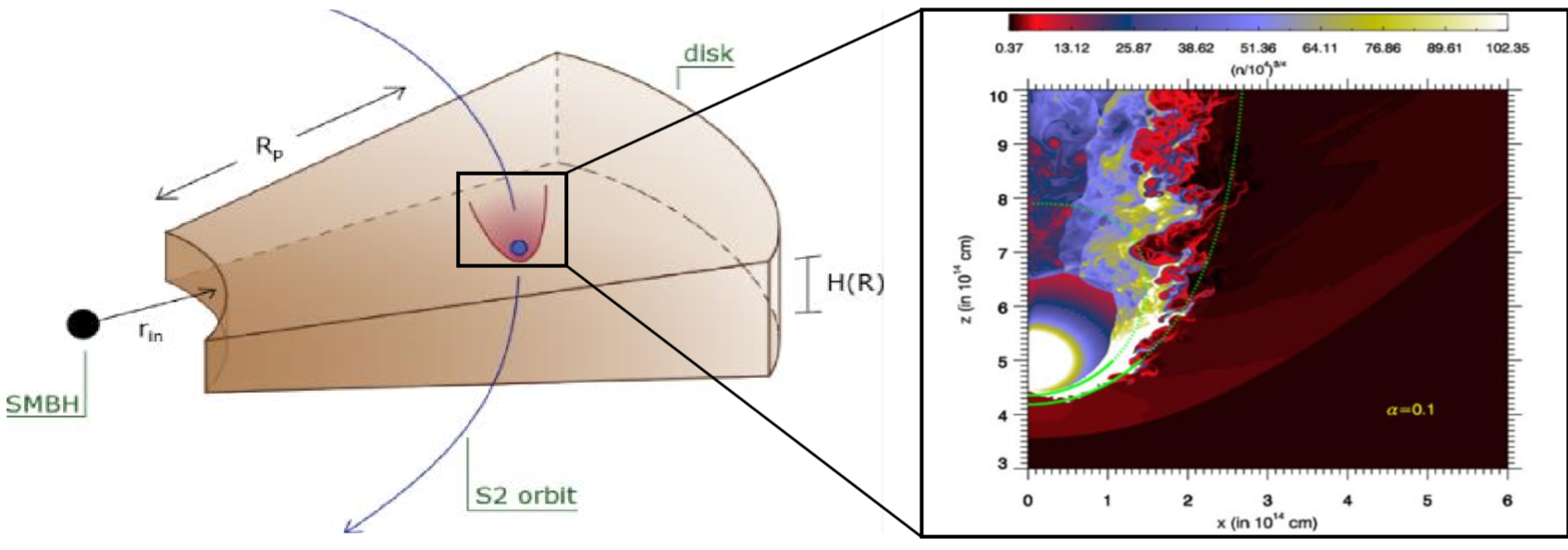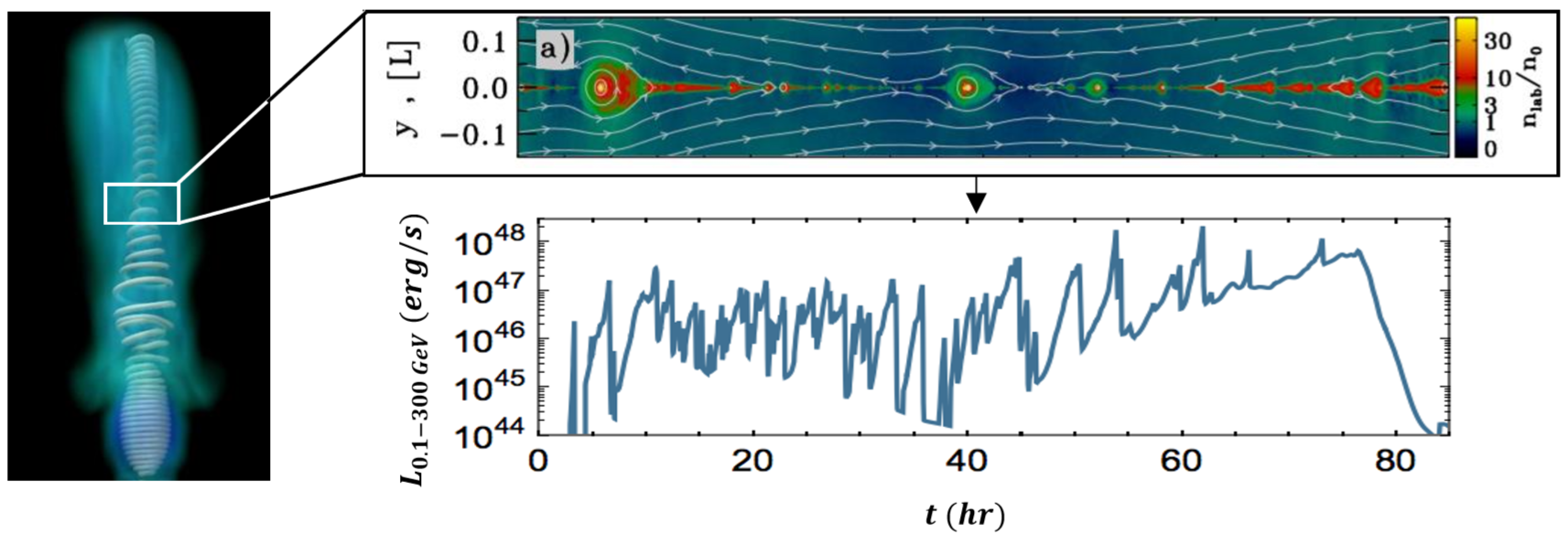Thermal & Non-Thermal Signatures in Galactic Nuclei
The centers of most galaxies are believed to harbor supermassive black holes (SMBH) millions of times more massive than our Sun. Only a small fraction of these black holes are fed gas at high rates, resulting in extremely bright active galactic nuclei (AGN). These large amounts of gas are then expelled, in the form of a collimated jet, out of the galaxy at speeds close to the speed of light. The remaining class of galactic nuclei are deemed low-luminosity AGN, in which the SMBH is starved of the local gas, thereby producing little radiation for us to observe. My doctoral research has focused on modeling the emission and inferring properties of the emission sites in both classes of galactic nuclei.
X-ray Transients & Radio Emission in Our Galactic Center
The SMBH in our Galactic Center (GC), classified as Sgr A*, is a perfect target to study low-luminosity AGN. Properties of the gas surrounding the SMBH (e.g., density, temperature, velocity) remain elusive despite numerous theoretical studies and large observational campaigns (e.g., Event Horizon Telescope, Chandra X-ray Telescope). We therefore require indirect methods of measuring the properties of the local gas. In my research, I’ve developed such models in which these properties can be probed via their interactions with stars residing close to the SMBH. As illustrated in Fig. 1, the spherically-outflowing stellar winds interact with the local gas resulting in a shock wave forming within the stellar winds. In my work, I’ve considered the interactions of the local gas with massive main-sequence stars as well as compact, fast-rotating neutron stars known as pulsars. I have shown that the emission produced from the shocked stellar winds can provide insights into the properties of the local gas. To accurately estimate the intensity of the radiation produced by the shocked wind, we require detailed information regarding the structure and geometry of the shock wave forming in the stellar wind. In (Christie et al. 2016, MNRAS), I developed a semi-analytical model which describes the geometry of the shock formed in the stellar wind. My solution not only reproduces those found in previous studies of stellar wind bow shocks, but also extends the shock model by exploring the effects of high-temperature gas on the overall geometry. This solution is applicable to many astrophysical systems and is particularly important when investigating the dual interactions of stellar winds of a binary star system (Petropoulou, Vasilopoulos, Christie et al. 2018, MNRAS).
An application of my model was first performed for the case of S2, a massive type-B star orbiting the SMBH in our Galactic Center and characterized by having the closest approach to Sgr A*. Through detailed analytical estimates and numerical hydrodynamic simulations (see right panel of Fig. 1), I demonstrated that the shock stellar wind can produce a month-long X-ray flare, via the thermal bremsstrahlung mechanism, with a peak luminosity exceeding that of current observations. This potential flaring event is within the detection capabilities of current X-ray instruments (e.g., NASA’s Chandra X-ray telescope), and its detection would allow us to constrain the density and temperature of the local gas surrounding Sgr A*. My model and its predictions will be put on firm ground as S2 makes its closest approach to Sgr A* in the Spring of 2018.
The observed spectrum and luminosity produced by the gas surrounding Sgr A* from Radio to X-ray frequencies is well accounted for by several theoretical models of radiatively-inefficient accretion flows. Although these models require a distribution of relativistic electrons to be present near the SMBH, in order to reproduce the observed Radio emission, they do not provide an origin for such a distribution. In (Christie et al. 2017, MNRAS), I proposed a possible origin for the required distribution via means of a pulsar orbiting the SMBH. The shock wave forming in the outflowing stellar winds of the pulsar, due to the interactions with the local gas (see Fig. 1), provides an excellent mechanism for accelerating electrons to high energies. These energetic particles can enter the local gas and cool, via the synchrotron radiation mechanism, within the local magnetic fields on long timescales (i.e., tens to thousands of years). With this simplified model, I demonstrated that the presence of a single pulsar is all that is required to reproduce the observed Radio spectrum and provides a natural explanation for the origin of the required distribution of electrons.

Fig. 1: (Left Panel) Sketch of a star’s transit through the local gas surrounding Sgr A* (Image Credit: Dr. S. Dimitrakoudis). Interactions between the gas and the outflowing stellar wind result in the wind being terminated by a strong shock (maroon line). The radiation produced by the shocked stellar wind (shaded, maroon region) is observable with current instruments and can provide insights into the properties and dynamics of the local gas. (Right Panel) Density plot of a numerical, hydrodynamic simulation snapshot displaying the interactions between the stellar wind of S2 and a hot, dense medium. My solution for the geometry of the termination shock in the wind, shown in green, is well fitted to the numerical results.
Blazar Variability & Magnetic Reconnection Driven Plasmoids
The observed radiation from AGNs is produced within a collimated, relativistic jet emanating from a SMBH. The emission from blazars, a subclass of AGN in which the relativistic jet is aligned with our line of sight, is found to be highly variable, with its luminosity changing by orders of magnitude on timescales ranging from minutes to weeks. This class of objects are observed to be variable across the entire electromagnetic spectrum. What powers blazar emission is ultimately related to how electrons are accelerated to ultra-relativistic speeds within magnetized fluids. An excellent candidate, which I’ve employed in my research, is referred to as magnetic reconnection, a process in which the energy stored within the local magnetic fields is transferred to electrons. This process is a result of magnetic instabilities occurring with the jet and can produce thousands of plasmoids, i.e., spherical blobs of magnetized fluid containing relativistic particles moving relativistically within the jet (see Fig.2). This dynamic process has been the extent of numerous theoretical and experimental studies and has many applications to various astrophysical phenomena (e.g., solar flares, pulsar winds). The relativistic regime of the reconnection process, most applicable to AGNs and blazars, can only be studied through detailed first-principle numerical simulations, which can nowadays properly simulate this process. In light of these recent simulations, I’ve assisted in the development of two numerical codes to test the reconnection model as a source blazar emission.
The first numerical model was a Monte Carlo (MC) code used to examine the effects of the plasmoid’s dynamics on the steady-state distributions of plasmoid sizes and momenta (Petropoulou, Christie, et al. 2018, MNRAS). This MC approach allowed for computationally-fast realizations, necessary for better understanding the statistical properties of the plasmoids produced by the reconnection process. I have shown that the size distribution of plasmoids constitutes a power-law, similar to results found in previous studies, which extend over several orders of magnitudes. In this work, I’ve also derived the power-law slope’s dependence upon individual processes which govern the motion and growth of plasmoids, thereby allowing us to pinpoint the exact processes which govern the shape of the size distribution. The results from our MC code are in good agreement with those produced from first-principle simulations and permit us to directly map them to astrophysical scales which cannot yet be directly simulated.

Fig. 2: (Left Panel) 3D simulation snapshot of a relativistic jet being launched from a SMBH, located at the bottom center of the panel (Barniol-Duran et al. 2017, MNRAS). Here, the shaded turquoise region represents the density of the material within the jet while the magnetic fields collimating the jet are presented in white. Magnetic instabilities occurring within jet trigger the magnetic reconnection process (Top Right Panel), in which spherical blobs of plasma (i.e., plasmoids), containing relativistic electrons, are launched from the jet at relativistic speeds towards an observer (Sironi et al. 2016, MNRAS). The emission produced by a chain of plasmoids is highly variable with flare durations lasting on timescales of several minutes to weeks (Bottom Right Panel) (Christie et al. 2018, in prep).
The second numerical code, which is the majority of my current research, is referred to as a radiative transfer code (Christie et al. 2018, in prep). This code properly tracks the evolution and resulting emission of relativistic electrons within each plasmoid throughout the entirety of the reconnection process. Here, I couple my code to the results of first-principle numerical simulations of relativistic magnetic reconnection. In doing so, I consider a variety of radiative processes which are expected to occur within a blazar jet (e.g., synchrotron, Compton processes) as well as several factors external to the jet which can affect the cumulative emission produced by a chain of plasmoids. A preliminary result is shown in the bottom right panel of Fig. 2. Here, I plot the integrated gamma-ray emission produced by a chain of 230 plasmoids, the dynamics of which are governed by first-principle numerical simulations. These results match well with current observations of blazars and can reproduce many characteristic features observed within blazar jets!